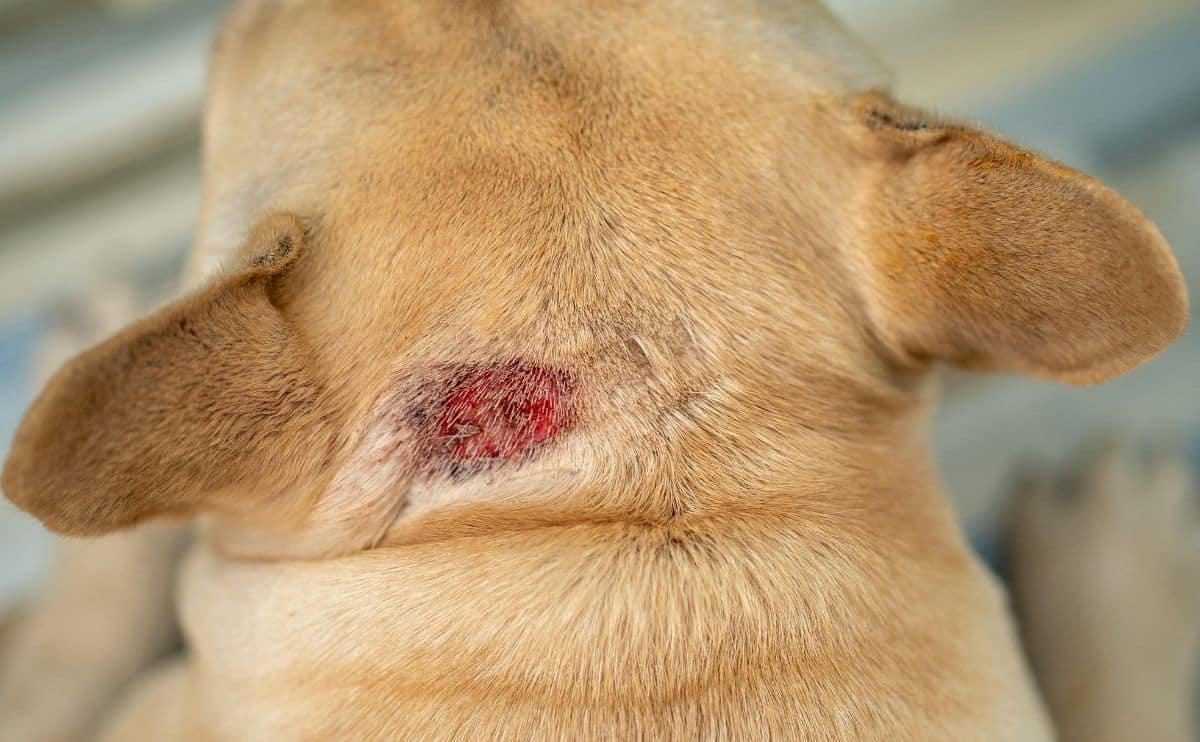Spleen Cancer In Dogs: Causes, Symptoms, Treatment & More
When you purchase through links on our site, we may earn a commission. Here’s how it works.

One of the most common and deadly forms of canine cancer is hemangiosarcoma, a malignant growth of blood vessels that most frequently affects the spleen. While any age, breed, or size can develop this type of spleen cancer, older and larger breeds are more at risk. We share the most important information you need to know about spleen cancer in dogs, including signs, types, treatment options, and outcomes.
Table of Contents
What Is A Splenic Mass In Dogs?
A splenic mass is a tumor within the spleen. Tumors result from the uncontrolled growth of cells and can be either benign (non-cancerous) or malignant (cancerous). In dogs, the spleen is a tongue-shaped organ in the abdomen that helps the body fight off infection and removes old red blood cells from circulation. It also helps the body produce red and white blood cells and stores some of the body’s red blood cells and platelets.
Splenic masses or tumors are common in dogs, particularly as they age, and they present a high risk for health problems. Both benign and malignant splenic tumors can rupture at any time, causing serious internal bleeding into the abdomen. Because the spleen stores and produces red blood cells, even benign tumors may be at risk of rupture and bleeding, causing acute illness.
Types Of Dog Spleen Tumors
The most common types of non-cancerous masses on the spleen in dogs are splenic hematomas (due to trauma) and nodular hyperplasias (due to the proliferation of cell growth). Canines can also develop a benign tumor of blood vessels, referred to as hemangioma.
Not to be confused with the similar-sounding benign tumor, hemangiosarcoma is a common malignant tumor of the spleen usually seen in older dogs (8–10 years of age). Less common malignant tumors that affect the spleen include lymphosarcoma, leiomyosarcoma, fibrosarcoma, and mast cell tumors.
Unfortunately, an estimated two-thirds of masses in the spleen in dogs are malignant, and two-thirds of malignant splenic tumors are diagnosed as hemangiosarcomas, according to the American College of Veterinary Surgeons (ACVS). And dogs who have a ruptured splenic mass requiring a blood transfusion are more likely to have hemangiosarcoma.
One study of 105 asymptomatic dogs with an incidental finding of a splenic mass indicated that 70.5% of cases involved benign tumors. Researchers also found that of the remaining 29.5% of canines who had malignant tumors, 58% were caused by hemangiosarcoma.
What Causes Spleen Cancer In Dogs?
Because the spleen is so vascular (meaning it’s rich in blood), it’s at a higher risk of abnormal cell growth. However, little is known about the causes of benign and malignant tumors in the spleen. While any dog can develop spleen cancer, genetics appears to play a role in some cases. Breeds that have a higher risk of spleen cancer include:
- Bernese Mountain Dogs
- Boxers
- German Shepherds
- Golden Retrievers
- Labrador Retrievers
- Standard Poodles
Symptoms Of Spleen Cancer In Dogs
Early dog spleen tumor symptoms for both benign and malignant forms can be nonexistent or very subtle, making it difficult for owners and even vets to spot. In many cases, signs don’t appear until the tumor ruptures and causes internal bleeding into the abdomen. When a rupture occurs, the rate of bleeding plays a major role in the severity of symptoms and how fast they present. A slow bleed may exhibit milder signs, while fast bleeds can result in sudden and severe symptoms. Common signs include:
- Decreased appetite
- Lethargy
- Weakness
- Pale gums
- Abdominal swelling
- Collapse
- Increased heart and respiratory rates
Dr. Hannah Godfrey, BVetMed, MRCVS, a small animal veterinarian in Cardiff, Wales, explains, “Cases of spleen cancer in dogs are always emotionally challenging because dogs with undiagnosed splenic masses usually appear healthy but suddenly collapse out of the blue due to internal bleeding. This means an emergency trip to the vet and not much time for owners to process the information given by the veterinarian and make a decision on how to proceed. Splenic tumors can be benign or cancerous and both tumors can cause internal bleeding and have a similar appearance on an ultrasound scan.”
How Is Spleen Cancer In Dogs Diagnosed?
Occasionally, a veterinarian will detect a splenic mass incidentally when running tests for unrelated conditions or during a check-up. But in most cases, the presence of a spleen tumor isn’t discovered until it has ruptured. Once this occurs, it’s often an emergency. Your vet may be able to presumptively diagnose a bleeding splenic tumor based on your dog’s symptoms and a physical exam (by palpating the abdomen to feel for a mass or fluid buildup).
Your vet may also conduct other testing to confirm a diagnosis, gauge the overall health of your pup, and prepare for surgery. These tests can include blood work, urinalysis, chest and abdominal x-rays and/or ultrasound, and examination of fluid obtained from the abdomen. If your vet suspects internal bleeding, they may perform coagulation (clotting) tests to determine if your pup needs a blood transfusion or is at risk for severe bleeding issues, particularly during surgery.
To look for evidence of metastasis (spread), your vet may also take x-rays of the lungs or perform an echocardiogram (ultrasound of the heart) to look for cancerous spread. But without a biopsy or examination of the removed spleen, vets can’t determine whether a tumor is cancerous or not.
Treatment Of Spleen Tumors In Dogs
In most cases of a splenic mass in dogs, vets recommend the total removal of the spleen, a procedure called a splenectomy. Spleen removal is usually preferred because even benign tumors can rupture at any time, causing severe or life-threatening problems. The spleen is not a vital organ, and dogs can live without one with no significant issues.
If the laboratory finds the mass benign, then surgery is curative and no other treatment is needed. However, with a malignant tumor, further treatment could include chemotherapy following surgery or palliative care. Unfortunately, the prognosis of malignant spleen cancer is grim.
How Much Does It Cost To Remove A Spleen From A Dog?
The cost of a dog splenectomy ranges anywhere from $1,000 to as much as $5,500. Spleen removal costs vary depending on the veterinarian fee, the complexity of the surgery, your geographical location, your dog’s size, and any special needs he may have, like a blood transfusion.
But keep in mind, you’ll face added costs for any prior diagnostic testing as well as laboratory testing to determine whether the mass was benign or malignant. And if you get the unfortunate news that the mass is cancerous and you opt for chemotherapy, then your costs will be significantly higher. Chemotherapy costs vary with the size of the dog and length of treatment, so chemotherapy may range from several hundred dollars to several thousand dollars.
Having pet insurance before a dog is diagnosed with conditions like cancer can save you thousands of dollars in vet bills. Learn more about pet insurance coverage for cancer and how it can help you financially.
Prognosis & Life Expectancy
While benign masses are curative using surgery, the same is not true for malignant spleen cancer. “The prognosis for hemangiosarcoma is very poor, with affected dogs only living for weeks or months before severe deterioration,” shares Dr. Godfrey. The problem is that hemangiosarcomas are very aggressive, and they commonly spread to the liver, lungs, heart, brain, skin, and muscles. So in most cases, the cancer has invaded other parts of the body by the time the spleen is removed.
Sadly, the life expectancy statistics for dogs with hemangiosarcoma are grim. The Morris Animal Foundation reports that 90% of dogs die within one year of diagnosis, despite surgery and chemotherapy treatment. The average survival time with surgery and chemotherapy is five to seven months. And for dogs who only have surgery, the average survival time drops to one to three months.
One Vet’s Experience With Dog Spleen Tumors
Dr. Hannah Godfrey shared her personal experience with us as a long-time veterinarian of companion animals.
“I remember a black Labrador who presented after having a wobbly episode on a walk. On examination, he had a high heart rate, pale gums, and a slightly bloated abdomen. An ultrasound scan showed that he had a mass on his spleen that had bled. While he had improved since his wobbly episode, I made the owners aware that it would likely happen again without surgery to remove his spleen, but that if it were cancerous the surgery would not be curative, and the cancer would progress quickly.”
“The owners decided to proceed with surgery, and, thankfully, the laboratory confirmed that the tumor was benign. However, I have also had very sad cases where dogs have recovered from surgery only to have the laboratory confirm a cancerous diagnosis.”
Frequently Asked Questions
Here are some questions pup owners often have about spleen cancer.
How Do You Prevent Spleen Cancer In Dogs?
If you’re wondering how to prevent spleen cancer in dogs, unfortunately, the answer is that there’s no known prevention. However, because older dogs and those of certain breeds are at a higher risk, regular vet check-ups are extremely important to detect any splenic tumors as early as possible.
Is Spleen Cancer In Dogs Painful?
Typically, splenic cancer doesn’t cause pain in the early stages of growth. And tumors can even grow very large before any clinical signs appear. In most cases, it’s only when the tumor ruptures and begins bleeding that dogs experience abdominal pain.
What Are The Final Stages Of Spleen Cancer In Dogs?
Signs that your dog is dying from hemangiosarcoma and bleeding internally include weakness and collapse, a rapid heart rate, panting or breathing fast, pale gums, and a distended abdomen. These symptoms mean that it’s critical to get your pup emergency care immediately.
While removal of the spleen can stave off immediate death, the hemangiosarcoma has likely spread to other parts of the body. The final stages of spleen cancer in dogs can involve chemotherapy to extend life for several more months, but the prognosis is extremely poor.
Managing The End Of A Dog’s Life
If you’ve received the unfortunate news that your pup has non-curative spleen cancer, we feel for you as fellow dog owners. A terminal diagnosis is one of the most devastating things we have to deal with. And it’s so hard to know when the time is right to ease your pup’s suffering and end his life. One of the most important things to consider when making this decision is the quality of your dog’s life. And remember that your vet is there to help you through this difficult choice.



